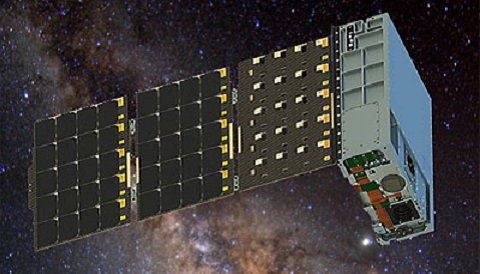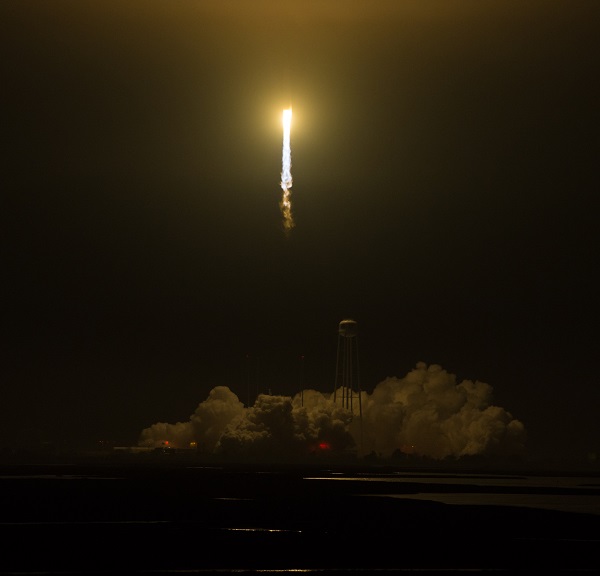HaloSat, a mini-satellite recently deployed from the International Space Station, is on the hunt for the universe's missing matter.

Blue Canyon Technologies
A small CubeSat mission may provide the data that answers a key cosmological question: where is half of the ordinary matter in the universe?
When astronomers attempt to measure the universe's total baryonic mass using modern surveys, they keep coming up short. The team behind HaloSat, built by Blue Canyon Technologies and run by the University of Iowa, looks to answer this question by looking at X-ray emissions from the gaseous halo thought to surround the Milky Way Galaxy.
The current tally of the universe's mass and energy distribution comes from analysis of the Cosmic Microwave Background (CMB), radiation released when the infant universe was just 370,000 years old. Measurements of this early era show that the universe is a mix of 70% dark energy, 25% dark matter, and 5% baryonic matter — the "normal" stuff, including protons, neutrons, and electrons, that makes up the stars, planets, spacecraft, and humans.

Nanoracks / NASA
Yet astronomers tallying up the observable measure of stars, planets, galaxies, gas, and dust only come up with about half of the baryonic mass they expect.
“We should have all the matter today that we had back when the Universe was 400,000 years old,” Philip Kaaret (University of Iowa) said in a recent press release. Finding the missing matter "can help us learn how we got from the CMB's uniform state to the large-scale structures we see today.”
One proposed location for the missing mass is the hot gas in the space between galaxies or in the halos around galaxies. For example, gas in the Milky Way's halo should run around 2 million Kelvin. HaloSat was designed, among other things, to detect the X-rays emitted by ionized oxygen associated with this gas.
Probing the Galactic Halo
There's one key problem to detecting this emission: The solar wind interacts with Earth's atmosphere to produce X-rays that swamp any signal from the galactic halo.
“Every observation we make has this solar wind emission in it to some degree, but it varies with the time and solar wind conditions,” Kip Kuntz (Johns Hopkins University) said in a recent press release. “The variations are so hard to calculate that many people just mention it and then ignore it in their observations.”
HaloSat will get around this by making observations during the 45-minute passes over Earth's nightside, recharging its solar-powered batteries during the daytime half of its 90-minute orbit.
HaloSat detects X-rays with energies between 400 and 2,000 electron-volts, the same regime as the Chandra and XMM-Newton space telescopes. But unlike these other orbiting X-ray observatories, HaloSat has a wide field of view, 100 square degrees, allowing it to carry out an efficient survey of the entire sky.
Researchers hope to use HaloSat to discern the shape of the Milky Way's galactic gas halo, to see if it follows more of the bulging pancake shape (the fried egg model) of the Milky Way galaxy itself, or is more of a sphere. If the distribution isn't uniform, HaloSat should see the difference, looking out perpendicular to the plane of the galaxy versus along the plane itself.
Launch & Deployment

NASA / Aubrey Gemignani
HaloSat was launched from NASA's Wallops Flight Facility on the Virginia coast on May 21, 2018, aboard the Cygnus S.S. J.R. Thompson spacecraft en route to the International Space Station. It was released from the ISS on July 13th.
Halosat is built around an XB1 CubeSat bus from Blue Canyon Technologies, and is equipped with reaction wheels, star trackers, and a solar panel. Although it's equipped for a wide-field survey, it has a pointing accuracy of better than 30 arc seconds. Its three X-ray detectors were built by Amptek Inc, and are similar to the ones on NASA's Neutron star Interior Composition Explorer aboard the ISS.
“We expect to operate HaloSat for one year,” says Kaaret. “We hope to show some preliminary results on one or a few bright targets within the Milky Way within that year, mostly to show how the instrument is operating. The results on the halo and the missing baryon problem will hopefully come 6-12 months after operations are done.”
It will be amazing to see if a small satellite mission such as HaloSat can answer such a big cosmological mystery.
 0
0









Comments
You must be logged in to post a comment.